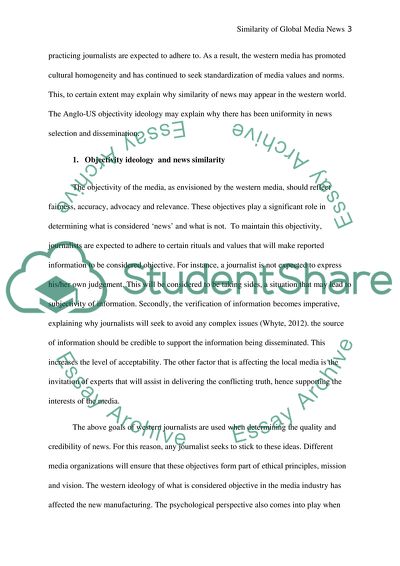Cite this document
(Similarity of Global Media News Essay Example | Topics and Well Written Essays - 3750 words, n.d.)
Similarity of Global Media News Essay Example | Topics and Well Written Essays - 3750 words. https://studentshare.org/journalism-communication/1863768-you-have-read-a-variety-of-research-into-the-sociology-of-how-news-is-manufactured-reflect-on-the-consistencies-and-inconsistencies-in-that-research-with-a-view-toward-explaining-why-aposnewsapos-tends-to-look-similar-across-different-publica
Similarity of Global Media News Essay Example | Topics and Well Written Essays - 3750 words. https://studentshare.org/journalism-communication/1863768-you-have-read-a-variety-of-research-into-the-sociology-of-how-news-is-manufactured-reflect-on-the-consistencies-and-inconsistencies-in-that-research-with-a-view-toward-explaining-why-aposnewsapos-tends-to-look-similar-across-different-publica
(Similarity of Global Media News Essay Example | Topics and Well Written Essays - 3750 Words)
Similarity of Global Media News Essay Example | Topics and Well Written Essays - 3750 Words. https://studentshare.org/journalism-communication/1863768-you-have-read-a-variety-of-research-into-the-sociology-of-how-news-is-manufactured-reflect-on-the-consistencies-and-inconsistencies-in-that-research-with-a-view-toward-explaining-why-aposnewsapos-tends-to-look-similar-across-different-publica.
Similarity of Global Media News Essay Example | Topics and Well Written Essays - 3750 Words. https://studentshare.org/journalism-communication/1863768-you-have-read-a-variety-of-research-into-the-sociology-of-how-news-is-manufactured-reflect-on-the-consistencies-and-inconsistencies-in-that-research-with-a-view-toward-explaining-why-aposnewsapos-tends-to-look-similar-across-different-publica.
“Similarity of Global Media News Essay Example | Topics and Well Written Essays - 3750 Words”. https://studentshare.org/journalism-communication/1863768-you-have-read-a-variety-of-research-into-the-sociology-of-how-news-is-manufactured-reflect-on-the-consistencies-and-inconsistencies-in-that-research-with-a-view-toward-explaining-why-aposnewsapos-tends-to-look-similar-across-different-publica.


